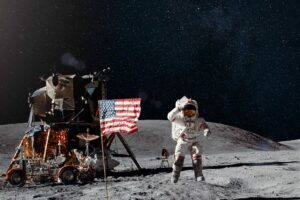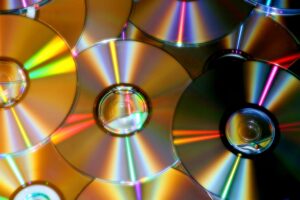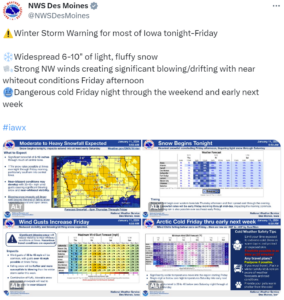DATA POINTS
- 3: The number of days until the Iowa Caucus
- 65: The percentage of in-bound movers who moved to Vermont in 2023
- -15: The expected temperature (without wind chill!) in Iowa for Caucus night
- 23: The number of state government offices that received a hoax bomb threat last Wednesday
- 3: The number of Heisman Trophy winners who have played for the Michigan Wolverines
- 16,000: The altitude (in feet) an Alaskan Airlines flight reached when a plug door panel flew off
 What to Expect When You’re Caucusing
What to Expect When You’re Caucusing
The Iowa caucuses are upon us again, and the field of GOP Presidential hopefuls are vying to top each other for a big night in the Hawkeye State. Each will go for gold, but even if they do not secure the top placement, they can generate momentum for future contests. Here are a few things to expect:
The night will be former President Trump’s to lose. Currently, Trump enjoys an average of 61% in the polls nationally. Given his national dominance and strong polling average in Iowa (53%), anything less than that on Caucus night – especially dipping beneath 50% — would be seized upon as evidence he is vulnerable. What would that mean? Firstly, his strong polling could translate into Trump-voter complacency, meaning Trump is more hare than tortoise when voters head to the polls. Secondly, a finish near 50% may be well ahead of the next finisher, but as the field continues to consolidate, any showing less than a clear majority carries risk of undermining the former president’s air of inevitability.
Florida Governor Ron DeSantis has ground to reclaim. DeSantis originally positioned himself as the ideal alternative for Trump, but his threat factor has waned against the giant. His campaign staff intended to set up the Iowa Caucuses as a break-even between the two candidates to demonstrate his viability, but with Haley now ahead in Iowa and New Hampshire, DeSantis needs a strong second-place finish to claim the most valuable prize Iowa has to offer: the candidate who exceeded expectations.
Former South Carolina Governor Nikki Haley needs a strong second-place showing – but not winning can be a win. A second-place position for Haley is likely to set up the one-on-one fight for the rest of the nomination. Unlike DeSantis, Haley has strong support in New Hampshire (with some polls showing a single-digit gap between her and Trump). Modern Republican nominating history shows that to be the nominee, a candidate needs to win two out of the first three nominating contests. The third one is Haley’s home state of South Carolina, where presumably, she would have a shot to capitalize on a New Hampshire win. Let’s not forget that New Hampshire has never picked the same winner as Iowa (don’t worry Granite Staters, Iowans don’t take it personally). For Haley, a strong second-place finish in Iowa is arguably better than a win. However, if she receives the bronze medal, or even simply fails to put meaningful space between her and DeSantis, she’ll have to continue with the brutal fight with him to be the alternative … while Trump will watch the proverbial gladiator match from the stands drinking a diet Coke.
It’s kickoff for election season and there will be highlights to see all year long.
Read More at The New York Times
AI Grows Up So Fast
It’s quite difficult to underscore the exponential rate at which AI is growing. Like how dolphins can swim immediately after being born but it takes human babies years to accomplish basic operations, AI is outpacing us at every turn (It’s just a metaphor. We know we haven’t found any dolphin-made civilizations … yet). Companies like OpenAI, Google, and Microsoft are feeding these neural networks more and more information to enhance their education (yes, education). Today, AI does a reasonable job at generating text, but shortly, it will hone its already impressive expertise in creating images and videos as well, and that is only what we see on the horizon.
The goal of these companies is to achieve “artificial general intelligence,” which could do everything that the human brain can do. Much like a human baby saying its first words, the most popular AI, at this point, is focusing its efforts on figuring out communication understandable to (and from) humans. Give that baby a decade or two, and it will be a musician and an accountant; it will learn about the world around it and understand the complexity of human emotions. Right now, AI is well on its way to doing these rudimentary things and will not need decades, as a human would, to mature.
Tech companies are merging AI networks, giving life to “multimodal” systems. Chatbots and image generators are being connected to create videos at a moment’s notice. Each specialization brings a new skill to the table, and much like a human, when two new skills are taught, they are used seamlessly to create something brand new, something unexpected.
As AI are taught new skills and increase their reasoning capacity, the goal is to have them solve increasingly complex problems that plague modern humanity. We will have to see what they create once multimodal systems are increasingly educated. And hope for the best!
Read More at The New York Times
Stanley Insanity: Take a Drink of Human History

Enter Stanley. Today, we call them “Tumblers” instead of chalices (a downgrade in terminology, if we are permitted to opine). The Stanley brand has become the go-to brand in hydration, with double-wall stainless steel to keep liquids at whatever temperature you want them to be. Each carries upward of 64 ounces while being able to fit into car cupholders. A testament to its value, a woman’s car caught on fire and one of the only things to survive was her Stanley – which still had unmelted ice.
With enough colors to appease the chalice artisans of old, and ergonomic science-based technology to suit the needs of the modern consumer, the Stanley has risen to the ranks of stardom. The same mementos we use to give our lives status, meaning, and enjoyment have largely remained the same but are continuously updated to reflect the time-locked society in which they exist.
Make Americans Read Again

It’s fair to say that we all need to read more – especially since the choice of book format (e-book, paper book, audiobook, etc.) transcends politics and demographics. While the most popular genres were history and mystery, neither is close to achieving most of the readership. 26% of men read a history book, compared to 13% of women. 25% of women read a mystery book, while only 15% of men did the same. The reader’s age tells a tale, too. Young readers prefer fantasy, millennials prefer history, and older generations pick mystery and crime novels. Those earning between $50-100K read more books than those earning $100K+, and both groups read more than those earning less than $50K, but the largest indicator is education. The higher the education, the higher the yearly book count.
How can you up your game? The average edition of The Weekender is 2,000 words. If you read all 52 editions this year, you’ll have read 104,000 words this year – the average length of a novel. If you read every week, we absolutely count that as adding another book to your 2024 lineup.
Read More at The Washington Post
More Space Between Moon Landings

Problems persist. NASA is relying on SpaceX’s Starship megarocket to not-so-gently carry the Artemis astronauts to the moon, but the rocket does not have a great track record (it exploded on both of its attempted flights). The next technical hurdle is the development of spacesuits being created by Houston’s Axiom Space. The lunar lander capsules have been experiencing stellar road bumps as well. Finally, the Starship will need to refill its tank 10 times in space. This will be unprecedented and carries more logistical and mathematical complications than fuel.
In the original space race, the U.S. pitted itself against the USSR to be the premier experts in space travel. Today, it fights against China to put the next set of footprints on the moon. While China may be a bit more cavalier to cross the lunar finish line first, NASA says “we don’t fly until it’s ready.”
Read More at The Associated Press
CDs Are Back, Baby

Additionally, CDs are full 44.1 kHz uncompressed digital audio, come with unique artwork, and allow fans to interact with the music tangibly. Plus, it solves the question of “what should I listen to today?” by having the full collection in eyesight.
For those who own vinyl, it’s clear that pulling the record out of its sleeve and giving it a flip is far more engaging than tapping an iPhone – and Gen Z couldn’t agree more with their burgeoning CD collections.
INTERNATIONAL SPOTLIGHT
A Case Study on War Shifting International Trade
When Vladimir Putin decided to invade Ukraine in 2022, the West decisively implemented strict economic sanctions and limited trade with Russia. Of course, Russia still had a growing need for modern goods and if the West could not be relied upon, they turned to their semi-allied countries in the geographic neighborhood. While North Korea and Iran have exchanged military equipment with Russia, China could not pass up the moment to bolster its own consumer goods exports – namely in the automotive industry.
Since the war in Ukraine’s first bloodshed, Chinese carmakers capitalized on the opportunity to seize the Russian demand for autos. The country’s auto dealers sold five times as many vehicles last year as they had in 2022, according to the China Passenger Car Association. Although China is making strides in the EV market, gas-powered vehicle sales have flourished in countries like Russia, and even Mexico, where demand is plenty. Chinese models have filled the Russian showrooms which were vacated by European, Japanese, and Korean brands.
Read More at The Wall Street Journal
Welcome to Iowa!
See you next week!
Be sure to follow us on Facebook, Twitter, and LinkedIn for more news and industry updates. To receive a copy of The Weekender in your inbox, sign up here.




 What to Expect When You’re Caucusing
What to Expect When You’re Caucusing


